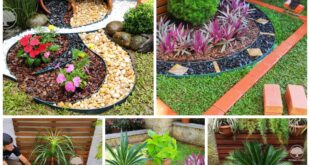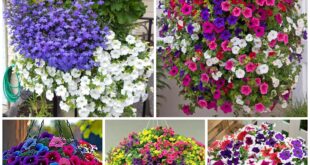Mandevilla vines have seen a resurgence in popularity in recent years, and breeding work continues to expand the vine’s mandavilla varieties.
Mandevillas are all about the big, tropical-looking blooms. They come in shades of pink, red, and white, and many shades in between. Now there’s a new color added to the range, a beautiful apricot. The large five-petaled blooms often have a rich golden throat inside that adds to the tropical look. Flowers are borne in clusters that will continue to grow and add more buds all the time. Be careful not to damage these growing points of the bloom clusters, or new buds will not form on that stalk. The size of the blooms can vary quite a bit depending on the variety. In general, smaller flowers tend to be much more abundant, and the larger blooms are a little more sparse but quite grand.
Although mandevilla is not classified as toxic to animals by the ASPCA, it can be mildly toxic when ingested, so keep the plant in a spot away from curious kids or pets. Also, the milky sap it exudes when cut can irritate skin upon contact.
Where to Plant Mandevilla
While mandevilla is usually grown as an annual because it dies when exposed to near-freezing temperatures, it can be overwintered indoors. It is perennial in the frost-free areas of USDA Hardiness Zones 10–11. Mandevilla is an excellent choice for the garden or patio.
How and When to Plant Mandevilla
Plant mandevilla outside in mid to late spring after the temperature consistently exceeds at least 50°F. Vining varieties benefit from a trellis or other support. If you plan to overwinter the plant indoors, plant it in a container with drainage holes and filled with all-purpose potting soil.
Mandevilla Care Tips
As far as care goes for these plants, mandevillas are low maintenance.
Light
Mandevilla needs 6 to 8 hours of full sun for best flower production. In the hottest regions, it benefits from some shade during the afternoon.
Soil and Water
When planting outside, select a site with good drainage and rich soil. Amend the planting area with compost or other organic matter to support the blooms. Water regularly to keep the soil moist but not overly wet.
Temperature and Humidity
The preferred temperature range for mandevilla that grows outside is 68–90°F. Anything lower than 50°F is likely to damage the plant. If the plant is overwintering indoors, keep the temperature in the 60–65°F range at night and 70°F or warmer in daytime.
Fertilizer
Like most vigorous plants that bloom for long periods, mandevilla benefits from a good dose of fertilizer every once in a while.
Pruning
If the plants get a little too wild for your liking, mandevilla can be pruned or trained to keep it in bounds. Plus, this will encourage more branching and blooms.
Potting and Repotting
When potting a mandevilla, use a lightweight, well-draining potting mix. Trim any dead or damaged roots, and position the plant at the same depth as in its previous container. Repot mandevilla every year or two in the spring in a pot only one size larger than the current container.
Pests and Problems
Mandevilla has no major pest problems, but it can attract mealybugs, aphids, and scale insects. The plant is usually ignored by deer and rabbits.
How to Propagate Mandevilla
You can propagate mandevilla from cuttings or seeds. In the spring, take 3-inch cuttings from the plant tip or side shoots and remove all but the top two leaves. Dip in rooting hormone and plant in a well-draining potting mix. When starting from seeds, use fresh seeds. Wait until they dry on the plant, then harvest the seeds, soak them in water overnight, and plant them in well-draining soil.
 careyfashion.com Carey Fashion
careyfashion.com Carey Fashion






















